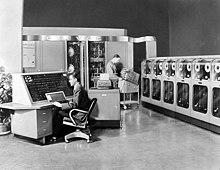
Back UNIVAC I AF الحاسوب الآلي العام (الإصدار الأول) Arabic UNIVAC I Catalan UNIVAC I Czech UNIVAC I German UNIVAC I Spanish UNIVAC I Finnish UNIVAC I French UNIVAC I Italian UNIVAC I Japanese



The UNIVAC I (Universal Automatic Computer I) was the first general-purpose electronic digital computer design for business application produced in the United States. It was designed principally by J. Presper Eckert and John Mauchly, the inventors of the ENIAC. Design work was started by their company, Eckert–Mauchly Computer Corporation (EMCC), and was completed after the company had been acquired by Remington Rand (which later became part of Sperry, now Unisys). In the years before successor models of the UNIVAC I appeared, the machine was simply known as "the UNIVAC".[1]
The first UNIVAC was accepted by the United States Census Bureau on March 31, 1951, and was dedicated on June 14 that year.[2][3] The fifth machine (built for the U.S. Atomic Energy Commission) was used by CBS to predict the result of the 1952 presidential election. With a sample of a mere 5.5% of the voter turnout, it famously predicted an Eisenhower landslide.[4]
- ^ Johnson, L.R., "Coming to grips with Univac," IEEE Annals of the History of Computing, vol. 28, no. 2, pp. 32, 42, April–June 2006. doi:10.1109/MAHC.2006.27
- ^ Reference: CNN's feature on the 50th anniversary of the UNIVAC.
- ^ Norberg, Arthur Lawrence (2005). Computers and Commerce: A Study of Technology and Management at Eckert-Mauchly Computer Company, Engineering Research Associates, and Remington Rand, 1946–1957. MIT Press. pp. 190, 217. ISBN 9780262140904.
- ^ Lukoff, Herman (1979). From Dits to Bits: A personal history of the electronic computer. Portland, Oregon: Robotics Press. pp. 127–131. ISBN 0-89661-002-0. LCCN 79-90567.